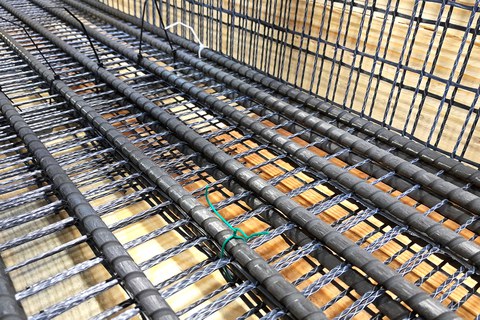Carbon concrete bridges in forestry
Table of contents
Project data
|
Titel | Title |
Report in the annual report 2021
Bridges for the forest

Carbon reinforcement cage in mould
Sachsenforst is a decentralized state enterprise and is responsible for the forest in Saxony as well as the existing traffic route network within it as part of its primary responsibility. In cooperation with PD (Projektpartner Deutschland), which supports public partners in the implementation of complex and innovative projects, modular bridge structures were designed for the subordinate traffic route network.
First of all, a comprehensive analysis of the existing infrastructure of the Sachsenforst was carried out with the aim of formulating specifications for the requirements of bridges in the traffic route network of the Sachsenforst. This showed that an economical modular construction method with high flexibility and high durability at the same time is the goal of the project. The carbon concrete construction method with its high durability in the humid climate of the forest promises enormous advantages compared to conventional reinforced concrete, steel and especially wooden bridges. Economic feasibility studies by the project partner PD prove the sustainability of the carbon concrete construction method - among other things due to the longer service life and lower maintenance costs.
In this specific case, longitudinally articulated precast elements with a constant structural height and carbon reinforcement were designed, which can be used variably for spans between 3 m and 9 m. The degree of reinforcement of the precast elements can be adapted to the specific requirements and varies depending on the span length. The thickness of the cast-in-place concrete, which is used for load distribution in the transverse direction is also variable. The weight of the robust bridge superstructure was reduced to a minimum by an arrangement of internal aerated concrete blocks. The effective thickness of the concrete structure with a channel-like precast cross-section is 7.5 cm.
In addition to the design and conception of these modular components, the Institute of Concrete Structures was also commissioned with the experimental verification of this innovative construction method. In coordination with the “Landesstelle für Bautechnik”, a corresponding test program was coordinated and carried out, thus setting the course for implementation of a pilot project. The large-scale 1 : 1 component tests were successfully carried out in 2021. A small-scale supplementary tests will be carried out in 2022, so that the “approval on an individual basis” (ZiE) required for new construction methods can be obtained.